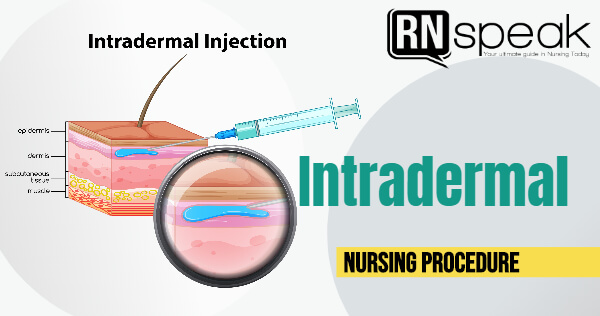Intradermal Injection is the injection of a tiny amount of fluid into the layer of the skin. It’s usually done to test for drug sensitivity before administering larger amounts by other methods.
Intradermal Injection Nursing Procedure
The procedure is usually painful, ensuring that the needle is inserted into the epidermis and not into the subcutaneous to reduce patient discomfort.
- Gather all the equipment needed and check the physician’s order
- Explain the procedure to the patient, the purpose, the site for injection, and how he/she has to cooperate.
- Wash hands and don disposable gloves
- Prepare medication from an ampule or vial.
- Position the patient and select the inner aspect of the forearm, upper chest, or upper back beneath the scapulae
- Cleanse the site with an alcohol swab in a circular motion moving outward. Allow skin to dry. Keep cotton in the clean tray for reuse when taking out the needle.
- Remove the needle cap with the non-dominant hand by pulling it straight off.
- Use the non-dominant hand to spread skin taut over the injection site.
- Place the needle almost flat against the patient’s skin. Insert 1/8- inch bevel up so that needle can be seen through the skin.
- Slowly inject the drug(0.01ml-0.1ml), watching for a bleb/blister to develop(the appearance of bleb/wheal indicates that the needle is in intradermal tissue). If not present, withdraw the needle slightly and inject the medication.
- Withdraw the needle quickly at the same angle as it was inserted
- Do not massage the area.
- Do not recap the needle. Discard the syringe and needle into the appropriate receptacle
- Remove gloves and wash hands.
- Record the medication administration-the medication administered, amount, dose, site, and patients response
- Draw a circle using a blue/black pen around the injection site. Write the date and time of administration of medication.
- Check the reaction within a specified interval of time; usually, it depends on the hospital protocols.
- Inform the physician of a medication reaction.
Important points to remember
- The redness wheal formation within 10-15 minutes is usually a sign of a positive test reaction.
- The patient should watch for at least 30 minutes for signs of allergy reactions.
- The following must be available for emergency treatment of penicillin anaphylaxis or generalized reactions.
-
- Epinephrine HCl 1:10 00 for immediate IM
- I.V. antihistamine
- 50/0 Dextrose in Water 1 liter and venosel.
Each Hospital has a policy on how the patient’s reaction will be evaluated and recorded. Always review the hospital policies to be sure of the process.




![Caring for Patients with Tracheostomy and Nursing Diagnoses [ Updates] tracheostomynursingprocedure](https://rnspeak.com/wp-content/uploads/2020/10/tracheostomynursingprocedure_725820712-238x178.jpg)



